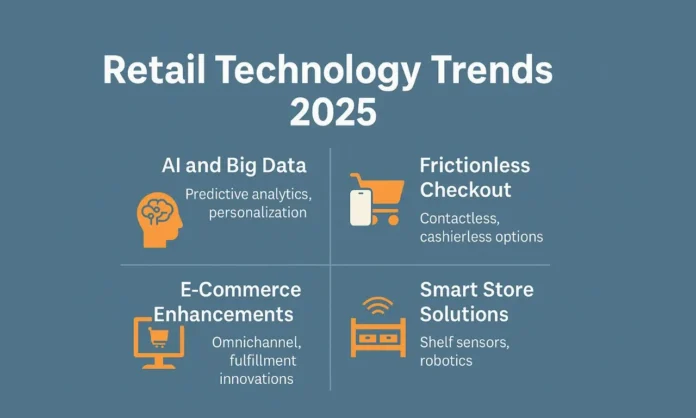Retail technology trends 2025 are not just about automation — they are reshaping how every part of a supermarket works. Whether it is how goods are stocked, how customers pay and in which form data is handled, the speed of change is increasing.
The difference between the quick tech retail giants and companies that lag behind is increasing. The intensifying competition in the supermarket industry is exerting pressure on businesses to invest, upgrade and adopt new things as quickly as possible. This report examines the way the chains in the industry are utilizing digital technology, AI and new retail infrastructure to compete and remain relevant in 2025.
Smart POS and Frictionless Checkout
One of the biggest shifts in retail technology trends 2025 is checkout transformation. The conventional till lanes are falling. Self-checkout is on the rise, but this time with other added levels of similarity: facial recognition log-ins, smart basket scanning and automatic payment through the retailer applications.
Loyalty apps are being integrated together with scan-and-go systems. There are tests of mobile-linked receipts, AI theft prevention, and dynamic queueing by retailers. There is a trial of checkout elimination using RFID in some supermarket formats where shoppers just walk out of the store and associated payment occurs via their app.
The benefit is that old-style cash registers will be replaced by cloud-based terminals at the POS level. What these terminals will do is provide immediate data syncing with recent updates in stocks and real time promotional targeting depending on the loyalty profile, time of day or location.
Predictive Retail Engines AI
Artificial intelligence is not longer an experiment. It is fuelling live pricing, replenishment, layout planning and basket targeting. Retailers are implementing predictive systems to predict surge in demand, automate the flow of orders, and minimize inventory loss of perishable items.

AI-powered hyperlocal assortment is one of those exemplars. The machine learning models are tailoring planograms by the store by the store according to weather, regional taste, and other micro-events. This implies that a shop in central London is able to carry varying dairy SKUs than the one in suburban Birmingham, with less stock outs.
The other driver is promotional efficiency. Retails employ AI as a means to know which offers to promote to which user and offer improved margin security and reduced discount leakage. Such systems are also able to sense cannibalization among near products and auto add campaigns.
In-Store Media and Digital Shelf
Retail technology trends 2025 include a major focus on digital shelf solutions. Supermarkets are transforming the edges of the shelves to smart displays with real-time pricing, ratings, with QR codes and advertisement placements.
These online screens are controlled at the center and synchronized with e-commerce sites. All locations are automated with price changes, label-changes and out of stock messages. Brand partners provide retailers revenue of new media along with control of the operation of the business.
There is also the growing of in-store media networks. There is now competition between brands to buy retail display time e.g. screen end cap, freezer screens, entrance screens. It is not just a case of online advertising in retail media, as advertising in-store is fast becoming a strong profit-generating model in the strategies around supermarket technology.
Fulfilment and Floor Ops robotics
There is an onward movement in the frontier of robotic automation on the back-ending. In 2025, order picking, stacking, and sorting are being done by the high-speed robots at the retail fulfilment centers. Micro-fulfilment centers built on urban stores are becoming an addition to the operations of some of the chains.

There is also a rise in floor robots. In most hypermarkets and large grocery stores, cleaning bots, shelf-scanning bots, and stock transporters work. Such machines are interfaced with cloud dashboards and maintenance warnings, which lessen human strain and enhance safety regulations.
The usage of the robots is not intended to substitute the labor of all people, but to decrease the repetitive strain work. Teams inside the store are also being trained to work together with robots and pay more attention to service, security, and fresh replenishment.
IoT and Inventory Accuracy
Retailers are embracing the Internet of Things (IoT) sensors to monitor the movement of their stocks including tracking cold chains and enhancing real-time inventory accuracies. The network of connected sensors can notify the managers about a possible breach of temperature, overstocks that can result in losses or shelf gaps that can result in lost sales.
These systems are also aiding in the aspect of sustainability. The manufacturers use IoT sensors to assist energy management in refrigeration and illumination, which helps in retail activities toward decarbonization. In large store formats, an efficiency incrustation of 2 percent provides a significant savings.
There is a growing use of RFID tags where the SKUs have been identified as high-theft or fast-moving brands. As part of AI, items, such as these tags, help prevent loss, as well as contribute to category team sales velocity data.
Cybersecurity, Cloud, and Infrastructure
Retailers are moving fundamental systems into the cloud. ERP, POS, supply chain dashboards, HR and training systems all are coming together in cloud ecosystems. This makes updates quicker, more secure and real time multi-site integration possible.
Cybersecurity has become part of everyday concern. As retail technology trends 2025 evolve, threats are rising. Supermarkets are directing more investments towards data encryption, fraud detection artificial intelligence and zero-trust network architecture. Phishing and data safety staff training is becoming a norm among frontline positions.
Downtimes of the system are unacceptable anymore. The chain stores having 100 or more stores are developing mirrored failover systems making sure the continuity of transactions 24/7.
Personalisation of Shopper Journey
Tech is being utilized to make shopping customized both in-store and online. Shelf shelf offers, shelf push notifications and even shelf lighting in certain test stores have their loyalty data associated with them.
Augmented reality (AR) applications are under trial to guide shoppers on bargains, prepare meals or learn about nutrition. Future-facing trials of format include voice assistants and app-based concierges.
Time, daypart and local demographics are made use of by retailers personalizing the in-store music, scent and light. It is not necessarily aimed at just selling more per basket – to affect dwell time and shopper satisfaction.
Retail Tech Partnerships And Ecosystems
Supermarket chains are also strengthening their collaboration with big tech companies. The largest grocery chains in Europe and Asia have now integrated Amazon-like checkout technologies, Microsoft Azure retail clouds, and Google Cloud Artificial intelligence tools.
Looking beyond investment in fintech, Walmart has invested in a range of startups including warehouse robots and loyalty startups. These collaborations enable accelerated testing and deployment, typically through pilot store conditions or local implementation.
By 2025, most supermarket chains will be developing more like tech firms, including innovation centers focused on CIOs, in-house laboratories and quickly deploying agile release teams.
Reporting and Sustainability Tech
Retail technology trends 2025 include tools for tracking sustainability performance. Stores and products Carbon calculators and ESG dashboards as well as impact reports are being used at the store and product level by retailers.
This is being traced with the use of traceability tech; Whether it is blockchain, barcode, or RFID, meat, seafood, produce and palm-oil-based products are being traced. This aids ethical sourcing and obligatory reporting requirements.
A lot of supermarkets are already correlating supplier performance in regard to emissions and water to procurement choices. Otherwise, eco-scores or local origin badges are displayed in-store as well.
Conclusion
Retail technology trends 2025 reflect a sector in transformation. Whether it is predictive AI, robotic fulfilment, digital shelf systems and sustainability dashboards, to name just a few, the technology is transforming every strata of supermarket strategy.
Early investments, smarter partnerships, and team training to work with digi are the main points about retailers who realize investment.



